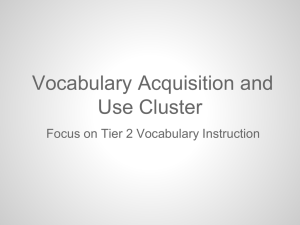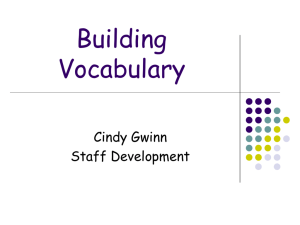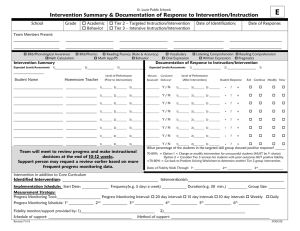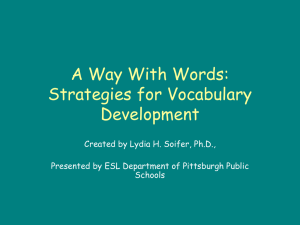A Context Driven Approach to Teaching Academic Vocabulary Sarah Robinson, PhD, CCC-SLP
advertisement
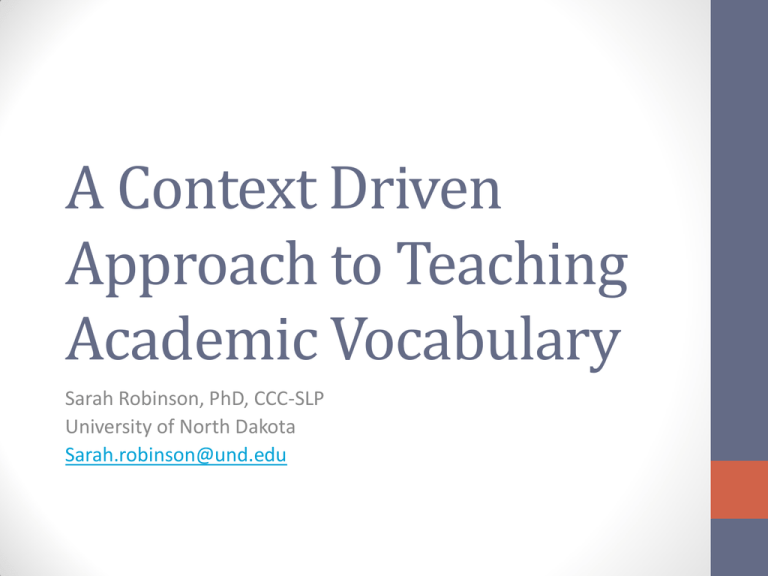
A Context Driven Approach to Teaching Academic Vocabulary Sarah Robinson, PhD, CCC-SLP University of North Dakota Sarah.robinson@und.edu Goals of today’s talk Participants will be able to: 1. 2. 3. 4. explain the importance of vocabulary in reading comprehension. state why it is important to explicitly teach vocabulary. identify target vocabulary words to teach (Tier 2, academic). use a three-step vocabulary strategy to teach academic vocabulary. Reading comprehension • What is reading? • What is the SLP’s role in reading? • Simple View of Reading (Gough & Tunmer, 1986; Hoover & Gough, 1990) Do we need to target reading? Reading comprehension on the SATs • According to the 2013 SAT Total Group Profile Report, the national reading average is down 34 points since 1972, whereas math scores currently stand five points above the 1972 national average. (College Board, 2013) How to target reading comprehension? Using context Bleak darkness was blacking out the sea and jungle when Rainsford sighted the lights. He came upon them as he turned a crook in the coast line; and his first thought was that he had come upon a (1) skanaslok, for there were many lights. But as he forged along he saw to his great 2) herskimadoo that all the lights were in one enormous building--a 3) goonle structure with pointed towers plunging upward into the 4) nackwalm. His eyes made out the shadowy outlines of a palatial 5) kicknspur; it was set on a high bluff, and on three sides of it cliffs dived down to where the sea licked greedy lips in the shadows. "Mirage," thought Rainsford. But it was no 6) tingpert, he found, when he opened the tall spiked iron gate. The stone steps were real enough; the massive door with a leering 7) hankshank for a knocker was real enough; yet above it all hung an air of 8) hooshslendoo. NAEP: Preliminary results of new data 2012 Congress Vocabulary instruction 1. What words should we teach? 2. How to teach them? Tiered vocabulary Tier Three Low frequency, specialized words that may appear in specific fields or content areas Tier Two Frequently occurring words that are central to comprehension Tier One Basic words that appear in most children’s vocabulary Beck, I. L., McKeown, M. G., & Kucan, L. (2002) More on tiered vocabulary Tier 3 • Mitosis, integer, cardiovascular, isthmus • Learned through the learning of academic concepts Tier 2 • Derive, alternate, contribute, contrast, generate • Most need deliberate instruction Tier 1 • Zebra, spoon, hot, scared, hungry, book • Generally acquire through natural exposure Not all tier 2 words are created equally….. Academic words Tier 2 words But….. Not all Tier 2 words academic words What are academic words? Typically broken into two categories: 1. General • Used in academic language with greater frequency than nonacademic words • Used across disciplines • Tend to be abstract 2. Discipline Specific • Words that are typically unique to a particular discipline • Tier III words (Hiebert & Lubliner, 2008) What are academic words? Words that occur frequently across a variety of academic materials Two primary lists: 1. Academic Word List (Coxhead, 2000) • 570 words • Drawn from a 3.5 million word corpus • Represents academic journals, textbooks, chapters of books and laboratory manuals 2. General Service List (West, 1953) New General Service List (Culligan & Browne, 2013) • 2,000 words drawn from 2.5 million word corpus • 963 drawn from a 288 million word corpus • Represents academic journals, textbooks, non-fiction text, student essays and academic discourse New General Service List abdominal absorb absorption accelerate acceleration accent accumulate accumulation accuracy accurately acid acidic activate actively acute adaptation adaptive adjacent Academic Word List abandon abstract academy access accommodate accompany accumulate accurate achieve acknowledge acquire adapt adequate adjacent adjust administrate adult advocate Academic Word List (AWL) • More than 80% of the words on the AWL are of Greek or Latin origin Sublists of the AWL concept conception concepts conceptual conceptualization conceptualize conceptualized conceptualizes conceptualizng conceptually Academic words resources • http://www.victoria.ac.nz/lals/resources/academicwordlist/a wl-headwords/Headwords-of-the-Academic-Word-List.pdf • http://www.newacademicwordlist.org/ Research with English Language Learners • 37 middle-school students, randomly assigned to two intervention groups • Intervention lasted for 75 minutes, 4 times per week • Experimental group received vocabulary instruction using the AWL • Results indicated growth in academic vocabulary and scores predicted a student’s readiness for mainstream academic subject classrooms (Townsend, D. & Collins, P., 2009) Research with English Language Learners • • • • • 6th grade students n=476 (high population of ELL or LM, n=346) 18-week program, 2 week cycle with a week of review 8-9 AWL words targeted per cycle 45 minutes of instruction, 4 days per week Experimental group vs. control grou • Gains in experimenter designed multiple choice test • Showed gains in Gates-MacGinitie reading comprehension test • Equivalent to 8-9 months of typical growth (Lesaux et al., 2010) Middle School AWL • Middle school students n=697 • Word generation program • 24 week program, targeting 5 words per week • Across all subject areas • Words introduced through novel texts • Pre-and post-test on 40 targeted words • Results suggest a 2 year gain in vocabulary abilities • Ongoing study – longitudinal data to be reported (Snow et al., 2009) Report of the National Reading Panel The need in vocabulary instruction research is great. Existing knowledge of vocabulary acquisition exceeds current knowledge of pedagogy. That is, a great deal is known about the ways in which vocabulary increases under highly controlled conditions, but much less is known about the ways in which such growth can be fostered in instructional contexts. There is a great need for the conduct of research on these topics in authentic school contexts, with real teachers, under real conditions. National Reading Panel (2000) Many researchers conclude that instruction on academic vocabulary in K-12 classrooms fail to reach the quality and intensity necessary for students to demonstrate knowledge of learned words. (Beck, McKeown, & Kucan, 2002; Biemiller, 2006; Gersten, Dimimo, Jayanthi, Kim & Santoro, 2010; McKeown, Beck, Omanson & Pople, 1985; Scott, Jamieson-Noel, & Asselin, 2003; Stahl & Fairbanks, 1986) Research on vocabulary instruction 1. 2. 3. 4. Teach within context Explicit is more effective than implicit Promote depth of processing Provide multiple encounters with target words (Beck et al., 2002; Blachowicz & Fisher, 2000; Graves, 2006; Stahl & Fairbanks, 1986) Vocabulary instruction • 72 teachers and reading specialists were polled • Main concerns: • How can we develop a consistent approach to vocabulary learning in my building/district? (n=28) • What are the best strategies/activities for vocabulary teaching? (n=17) (Berne & Blachowicz, 2008) Teaching through reading program How to teach academic vocabulary 1. Research-based • Compare practices of good readers/poor readers • Comprehension monitoring • Using context • Generalizing beyond context 2. Practical • Simple and efficient for teachers to implement Word learning process 1. Triggering • when a sounds sequence (word) is encountered, existing representations will be activated • lexical match or new word 2. Lexical configuration • sound sequence is stored with the referent 3. Lexical engagement • Memory consolidation linked to episodic memory (Leach & Samuel, 2007; Storkel & Lee, 2011) The Strategy 1. Comprehension monitoring • Teach kids to evaluate whether or not they know words 2. Apply vocabulary knowledge scale (VKS) • 1: I have no idea what this word means. • 2: I think I’ve heard this word before. • 3: I think this word means…… • 4: I can tell you the definition of this word 3. Word web • Creating context, making connections, generalizing Pilot year in the district • Asked teachers to try the strategy • Collected feedback • Time • Books • Practicality Pilot kindergarten study • 2 classrooms • Materials (books) were the same • Targeted the same 12 words over 15 weeks • One used the 3 step strategy, other relied on context alone • Pre- and post-testing using the ZOT Results Targeted words Control words estimate inspect similar dismay expert convince inspire approach exchange outcome emerge anticipate detect concentrate* realize cycle investigate indicate enormous require challenge create consult unique* Results Results Results Future direction 1. Replicate with greater number of students across several grades 2. Incorporate into broader language arts curriculum 3. Measure impact on reading comprehension 4. Determine additional level of intervention necessary for students with language-based learning disabilities

